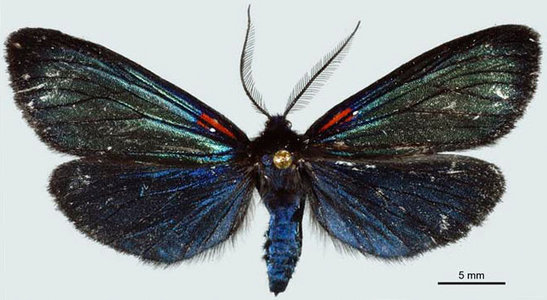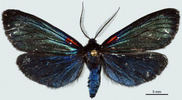Scea necyria
James S. Miller and Andrew V. Z. BrowerIntroduction
Unlike most of its congeners, Scea necyria is widespread throughout the Amazonian slopes of the Andes from Colombia to Peru. The atypical wing pattern (shared with S. bellona) resulted in its being described in a separate genus (see nomenclature, below) which Miller (2009) has synonymized. Larvae feed on Passiflora species, and the moth was introduced to Hawai'i in an unsuccessful effort to exert biological control over P. mollissima (Markin et al., 1989).Characteristics
The iridescent blue-black wings with red basal dashes on the forewings are unique among Josiini, aside from its larger sister species, N. bellona. Miller (2009) notes two additional undescribed species from Peru that belong in this clade.Nomenclature
S. necyria was originally described in the genus Sangala (Geometridae), and subsequently associated with Dioptinae by Prout (1918), who erected the genus Cyanotricha, for this species and "Tuina" bellona Druce (Tuina is a genus af Arctiidae). Miller's (2009) phylogenetic analysis revealed Cyanotricha to be embedded within a paraphyletic Scea, and so elected to synonymize the former.References
Markin, GP, RF Nagata and G Taniguchi. 1989. Biology and behavior of the South American moth Cyanotricha necyria (Lepidoptera: Notodontidae), a potential biocontrol agent in Hawaii of the forest weed Passiflora mollissima (HBK) Bailey. Proceedings of the Hawaiian Entomological Society 29, 115-123.
Miller, JS. 2009. Generic revision of the Dioptinae (Lepidoptera: Noctuoidea: Notodontidae). Bulletin of the American Museum of Natural History 321, 1-971 + 48 plates.
Title Illustrations

| Scientific Name | Scea necyria |
|---|---|
| Location | Ecuador: Loja, 17 km w. Loja on old Catamayo-Loja Rd., 03°59.9'S, 79°15.7'W, 2675 m. |
| Reference | Miller JS. 2009. Generic revision of the Dioptinae (Lepidoptera: Noctuoidea: Notodontidae). Bulletin of the American Museum of Natural History 321, 1-971 + 48 plates. (Plate 34) |
| Specimen Condition | Dead Specimen |
| Identified By | James S. Miller |
| Sex | Male |
| Life Cycle Stage | adult |
| View | dorsal |
| Collection | AMNH |
| Collector | J. S. Miller, E. Tapia & S. Rab Green |
| Image Use |
 This media file is licensed under the Creative Commons Attribution License - Version 3.0. This media file is licensed under the Creative Commons Attribution License - Version 3.0.
|
| Copyright |
© 2009

|
About This Page

Middle Tennessee State University, Murfreesboro, Tennessee, USA
Correspondence regarding this page should be directed to James S. Miller at and Andrew V. Z. Brower at
Page copyright © 2010 and
 Page: Tree of Life
Scea necyria .
Authored by
James S. Miller and Andrew V. Z. Brower.
The TEXT of this page is licensed under the
Creative Commons Attribution-NonCommercial License - Version 3.0. Note that images and other media
featured on this page are each governed by their own license, and they may or may not be available
for reuse. Click on an image or a media link to access the media data window, which provides the
relevant licensing information. For the general terms and conditions of ToL material reuse and
redistribution, please see the Tree of Life Copyright
Policies.
Page: Tree of Life
Scea necyria .
Authored by
James S. Miller and Andrew V. Z. Brower.
The TEXT of this page is licensed under the
Creative Commons Attribution-NonCommercial License - Version 3.0. Note that images and other media
featured on this page are each governed by their own license, and they may or may not be available
for reuse. Click on an image or a media link to access the media data window, which provides the
relevant licensing information. For the general terms and conditions of ToL material reuse and
redistribution, please see the Tree of Life Copyright
Policies.
- First online 10 January 2010
- Content changed 10 January 2010
Citing this page:
Miller, James S. and Andrew V. Z. Brower. 2010. Scea necyria . Version 10 January 2010 (under construction). http://tolweb.org/Scea_necyria/138760/2010.01.10 in The Tree of Life Web Project, http://tolweb.org/








 Go to quick links
Go to quick search
Go to navigation for this section of the ToL site
Go to detailed links for the ToL site
Go to quick links
Go to quick search
Go to navigation for this section of the ToL site
Go to detailed links for the ToL site